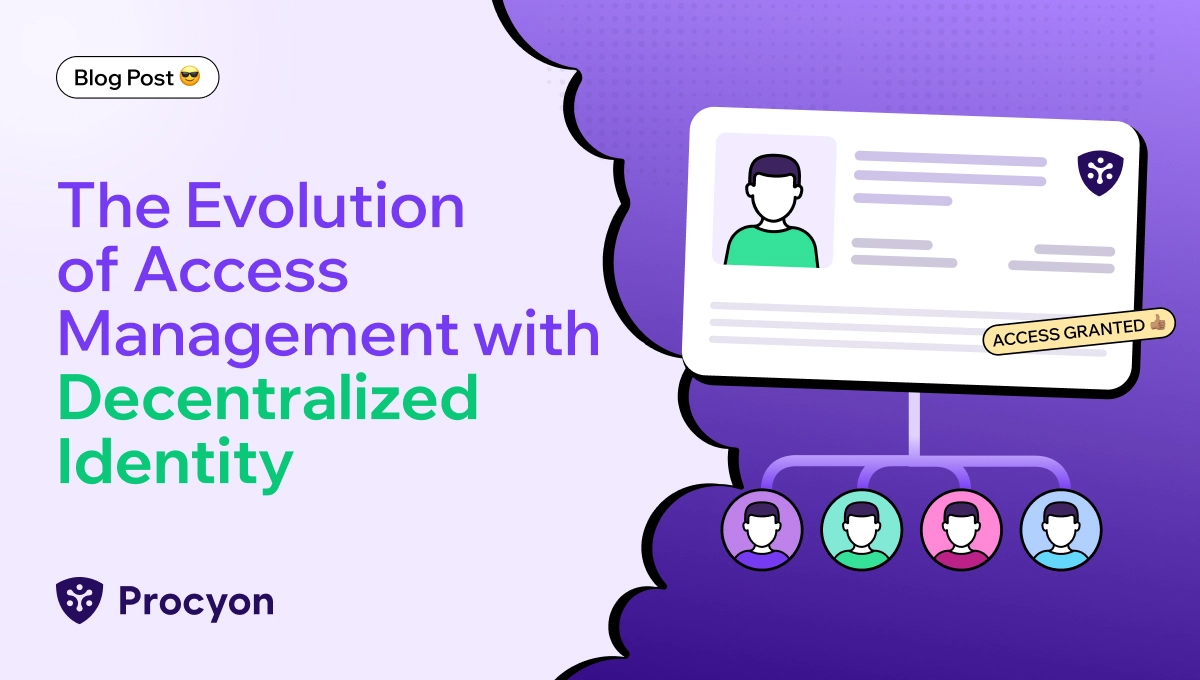Procyon Dictionary
decentralized identity
[dee-sen-truh-lahyzd, ahy-den-ti-tee]
Decentralized identity is a system where individuals control their own identity information without relying on a central authority. Using technologies like blockchain, decentralized identity allows users to manage, share, and verify their personal data securely and privately. It enhances privacy, reduces the risk of data breaches, and enables seamless interaction across different platforms and services.
The Current Landscape: Traditional IAM and its Limitations
Traditional IAM systems, though essential for controlling access to resources, can present significant challenges that hinder developers’ productivity and adherence to security best practices. Below are some of the most common issues:
-
- Slow Provisioning: Traditionally, IAM relies on IT staff to manually grant access to resources. This process can be slow and create bottlenecks, delaying developers from getting the access they need to be productive.
- Complex User Management: Traditional IAM can make adding, removing, and updating user permissions across multiple systems complex and error-prone. If old permissions are not revoked correctly, this can lead to security vulnerabilities.
- Inflexible Controls: Traditional IAM systems may struggle to keep up with the dynamic and ever-changing needs of modern development environments. They may not offer the granular control developers need to grant access to specific resources or functions within an application.
- Siloed Access: Legacy IAM systems often manage access for different tools and applications in isolation. This can make it difficult for developers to get a holistic view of user permissions and create a unified security posture.
- Security Risks: Manual processes and slow provisioning can create security vulnerabilities. Developers frustrated by slow IAM processes may resort to workarounds that could expose sensitive data.
- Centralized IAM: Imagine a single vault storing all your user data—a goldmine for cybercriminals. A data breach here can expose sensitive data and compromise all identities managed within the system. This centralized approach increases the attack surface and makes the system a lucrative target for cybercriminals. Besides, it can struggle to adapt to the ever-increasing number of users and devices within the digital ecosystem.
Decentralized Identity: A Paradigm Shift
Blockchain technology, the secure distributed ledger system underpinning cryptocurrencies, offers a revolutionary solution for IAM. The introduction of Decentralized Identity (DID) leverages blockchain principles to create a user-centric approach to identity management, fundamentally transforming access management. It offers developers and security leaders unprecedented control over their digital identities. Here’s how it works:
Digital Wallets and DIDsInstead of relying on companies to manage your identity, you'll possess a digital wallet containing a DID. This unique identifier acts as your online identity, but unlike usernames, you control it. |
Verifiable Credentials (VCs)Imagine your educational certificates, age verification, or professional licenses as secure digital documents. These are VCs issued by authorized entities and linked to your DID. |
Selective SharingIn a DID-based future, you decide which VCs to share with organizations for access. This empowers you to control what information you reveal and for what purpose. |
Key Features of Blockchain in IAM
The strength of blockchain technology lies in its ability to provide secure, reliable, and transparent identity management. Here are the key features that make blockchain an ideal solution:
-
- Permanent Ledger: Blockchain’s permanent nature ensures that once data is written, it cannot be altered or deleted, providing a trustworthy record of identity transactions. This immutability is vital for maintaining the integrity of identity data and ensuring traceability.
- Decentralization: Distributing the ledger across a network of computers (nodes) eliminates a central point of vulnerability for blockchain. This distributed approach makes large-scale breaches highly unlikely. Additionally, each node holding a copy of the entire ledger ensures the network’s ability to bounce back from attacks and stay continuously available.
- Cryptographic Security: Blockchain utilizes advanced cryptographic techniques to secure identity data, ensuring that only authorized parties can access sensitive information. Public and private key pairs authenticate users and authorize transactions, providing robust security.
-
How Blockchain Revolutionizes IAM or The Advantages
The shift towards Decentralized IAM represents a transformative change in how identities are managed and secured. This approach offers a multitude of benefits for both users and organizations, fundamentally securing and enhancing access management. The advantages include:
-
- User-Controlled Identities: Blockchain enables Self-Sovereign Identity (SSI), a paradigm shift where users have complete control over their digital identities without relying on a central authority. Users can store their identity information on a blockchain and selectively share it with service providers as needed. This model shifts the control of personal data back to the individual, allowing users to manage their identities with greater autonomy. With SSI, users can disclose only the necessary information to service providers, reducing the risk of data overexposure. For example, when proving age, a user can provide a simple “Yes” or “No” answer instead of sharing their full birthdate, enhancing privacy.
- Enhanced Security: Decentralized identity systems significantly reduce the attack surface by eliminating central databases that are prime targets for hackers. Instead of a single database holding millions of identities, the data is distributed, making it harder for attackers to achieve large-scale breaches. The permanent nature of Blockchain ensures that identity records are tamper-proof, making it difficult for malicious actors to alter identity information. This guarantees the integrity of identity data, which is crucial for trust in digital interactions. Advanced cryptography takes blockchain security to the next level, securing authorized access to sensitive information.
- Seamless Collaboration: Blockchain-based identity systems adhere to standardized protocols like Decentralized Identifiers (DID) and Verifiable Credentials (VC), which are critical for developers and security leaders. These protocols ensure that identity solutions are not siloed but can seamlessly integrate and interact across various platforms and services. This interoperability acts as the bridge between disparate systems, creating a cohesive identity management ecosystem. This allows for effortless verification and utilization of identities across platforms, eliminating duplication and compatibility problems.
- Streamlined Access Management: Blockchain streamlines access management by automating the process through smart contracts. For instance, a smart contract can grant or revoke access based on predefined conditions without human intervention. This automation reduces administrative overhead and minimizes the risk of human error. Every transaction on a blockchain is recorded and timestamped, providing an auditable trail of access management activities. This transparency ensures accountability and simplifies compliance with regulatory requirements. The ability to automate and audit access management processes can lead to more efficient and secure systems.
-
Revolutionizing Identity Management with Decentralized IAM or Benefits of Blockchain-based IAM

Opportunities and Considerations
Integrating blockchain into Identity and Access Management (IAM) opens up numerous exciting opportunities. To ensure successful implementation, it is crucial to address several key considerations, including:
-
- Scalability: Enhancing blockchain networks to handle large transaction volumes is essential. Innovations like sharding and off-chain transactions are being developed to improve scalability, making blockchain-based IAM systems more efficient and capable of supporting enterprise demands.
- Regulatory Compliance: Ensuring blockchain-based IAM systems comply with data protection regulations like GDPR is essential for their adoption. This involves implementing mechanisms for data erasure and ensuring user consent management. Engaging with regulatory bodies and following best practices can help achieve compliance and build user trust.
- User Adoption: Building trust in decentralized identity requires educating the user about its benefits. Developing user-friendly interfaces and seamless onboarding processes can drive adoption by making these systems accessible and easy to use. Empowering users to control their digital identities enhances security and privacy.
- Interoperability: Achieving interoperability across different blockchain networks and existing IAM systems requires ongoing development and standardization. Collaboration between industry stakeholders and adherence to global standards can lead to seamless integration and broader adoption of decentralized identity solutions.
By addressing these considerations, security leaders and developers can unlock the full potential of blockchain-based IAM, leading to more secure, user-controlled, and interoperable digital identities.
Blockchain’s integration with IAM systems unlocks a future of secure, transparent, and user-controlled digital identities. Decentralized identity offers a strong foundation for secure and user-centric management. As Blockchain matures and overcomes existing hurdles, it has the potential to become a transformative force in the future of IAM, revolutionizing how we handle and safeguard our digital identities.

